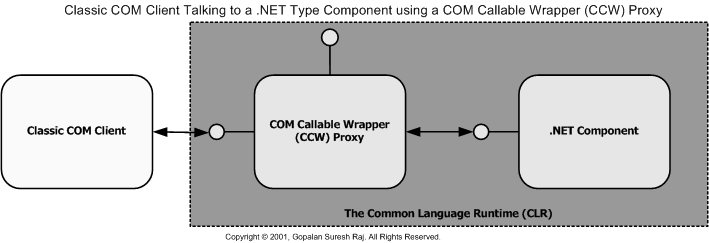Classic COM to
.NET Interoperability
Gopalan Suresh Raj
| Note |
| To
work with any of these samples, you will need the
following: .........................................Microsoft .NET SDK .........................................Microsoft Visual Studio.NET Beta 2 or higher |
The Problem
To make a COM Client use a .NET type component Server as though it were accessing another regular COM Server, we have to expose a COM coclass and make the client believe that the managed .NET type component is somehow unmanaged!!! This means, there has to be a mechanism to interact with the .NET type component using the functionality provided by COM. This also means, the COM Client should be able to obtain new interfaces through QueryInterface() calls, mimic unmanaged memory management using AddRef() and Release(), make use of the COM Connection Point protocol, etc.
In addition to fooling the COM Client, COM to .NET interoperability also has to simulate COM functionality to the COM Runtime. For instance, a Classic COM Server is activated using the Service Control Manager (SCM). This means, when the SCM looks-up for numerous bits of information in the system registry (like ProgID, CLSID, IID, etc.), the information is available for it to use. The main problem is that .NET assemblies are not registered at all.
The Rules
To make .NET assemblies available to classic COM Clients, the following has to be done:
.NET Assemblies have to be registered into the System Registry to allow the COM SCM to locate them.
A COM Type Library (.tlb) file has to be generated using the .NET metadata to allow COM clients to interact with exposed COM type components.
The Assembly has to be deployed in the same directory as the COM Client, or has to be installed into the Global Assembly Cache (GAC).
The Solution
When COM Clients access a .NET Type Component that's masquerading as a COM type, the .NET Common Language Runtime (CLR) uses a proxy called the COM Callable Wrapper (CCW) to negotiate "COM to .NET communication" as shown in the figure below.

The Classic COM Client assumes that the CCW Proxy object is a real COM object and assumes that it abides by the rules of AddRef() and Release(). The CCW in reality, is a reference counted entity. When the COM Client has issued the final release, the CCW Proxy releases its reference to the real .NET Component, at which point the .NET Component is ready to be garbage collected, just as a Classic COM Server object would.
To further the illusion that it represents an actual COM coclass, the CCW implements a number of COM interfaces automatically, in addition to the set of custom interfaces defined by the .NET Component.
To illustrate Classic COM to .NET Interoperability, we develop a Classic COM Server using C# and .NET. We then develop Classic COM client applications using Visual Basic ver 6.0 which accesses our server. In addition we also demonstrate how to access our server with Managed C++ Clients using both early, and late binding.
Download the entire source code as a zip file.
click here to go
to
My
Advanced C#/.NET Tutorial Page...
| About the Author... |
| Gopalan Suresh Raj is a Software Architect, Developer and an active Author. He has co-authored a number of books including "Professional JMS", "Enterprise Java Computing-Applications and Architecture" and "The Awesome Power of JavaBeans". His expertise spans enterprise component architectures and distributed object computing. Visit him at his Web Cornucopia© site (https://gsraj.tripod.com/) or mail him at gopalan@gmx.net. |
This site was developed and is maintained by Gopalan Suresh Raj This page has been visited
|
||
Last Updated : Dec 27, '01 |
||
Copyright (c) 1997-2001, Gopalan Suresh Raj - All rights reserved. Terms of use. |
All products and companies mentioned at this site are trademarks of their respective owners. |